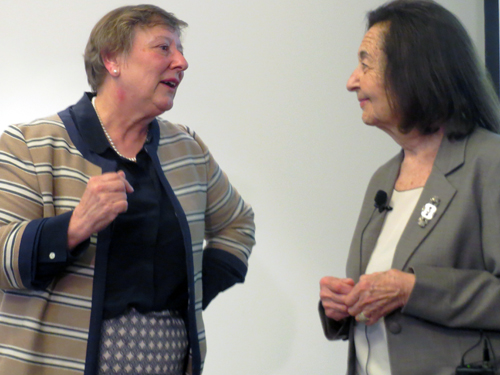
Sarah Thomas, vice president of the Harvard Library, delivered the inaugural Judith Nadler Vision Lecture at the University of Chicago’s Joseph Regenstein Library on May 22. The lecture series was launched in honor of Nadler, who is retiring June 30 as director and university librarian since 2004 after a total of 48 years at the University of Chicago Library.
Thomas’s talk, “Future-Proofing the Research Library,” was attended by some 200 people and examined the many ways that academic libraries are adapting to the changes in their campus roles. In the past, Thomas said, libraries were constructed in an “imposing style that physically reflected the sentiment, ‘Knowledge is power’”—such as Harvard’s Widener Library, where Thomas worked as a cataloger in the 1970s.
Now, library architecture is less about an expression of vast collections and bibliographic control and more about “transformation and evolution,” Thomas said, with expanded public spaces, visualization walls (such as the one at North Carolina State University’s Hunt Library), exhibition and maker spaces, and technology-enabled classrooms. This contrast is readily seen by comparing the brutalistic exterior of the Regenstein Library (built in 1970) and the glass-domed, futuristic Joe and Rika Mansueto Library next door (completed in 2011 through Nadler’s vision and planning) with its robotic book retrieval system and centralized conservation and digitization laboratories.
According to the Extinction Timeline 1950–2050, a chart based on the ideas in Richard Watson’s Future Files: The 5 Trends That Will Shape the Next 50 Years (Nicholas Brealey, 2008), libraries are supposed to become obsolete by 2019, along with post offices, butchers, free parking, and sit-down breakfasts. Thomas pointed out that the chart assumes that libraries will fail to transform and evolve, a process that they have been doing for decades. The all-important, light-green bound, multivolume National Union Catalog Pre-1956 Imprints that began publication in 1968 at a total cost of $34 million is now routinely used by libraries to build bookish Christmas trees, Thomas joked.
Thomas presented an overview of the strategic thinking and design planning that the Association of Research Libraries (ARL) has been working on since October 2013 to address this vision concept: “In 2033, the research library will have shifted from its role as a knowledge service provider within the university to become a collaborative partner within a rich and diverse learning and research ecosystem.” She said that ARL’s blueprint will serve as a primary document for future-proofing the research library, encouraging the development of such services as coordinated and collaborative management of collections, scholarly publishing at scale, data mining, innovation laboratories, and expanded staff skills.
What academic libraries need to do to remain relevant, Thomas said, is to replicate the “spirit that Judith Nadler has instilled in those around her to do better.” These characteristics include:
- great leadership;
- a sense of history;
- the skill to avoid the pitfalls of discarding what is precious;
- the insight to break away from the known to the unknown;
- flexibility to accommodate change;
- the ability to connect with other people and institutions;
- strong values and an ethical code;
- commitment to the stewardship of cultural heritage; and
- respect for all who benefit from libraries and librarians.
Underpinning all this change, Thomas concluded, is Nadler’s “enormous faith in technology.”
The Judith Nadler Vision Lecture series is expected to be an annual event.


